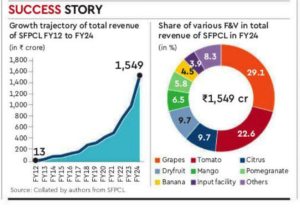The success of Sahyadri farms presents a blue print for the fruits and vegetables sector.
India’s fruits and vegetables (F&V) sector is growing faster than cereals, contributing roughly 30% to the value of crop agriculture. It is also more nutritious. Yet, it receives far less policy focus and institutional support compared to cereals. Without organised value chains, proper storage, or adequate processing facilities, the F&V sector remains highly vulnerable to seasonal gluts, price crashes, and post-harvest losses. Around 8.1% for fruits and 7.3% for vegetables are lost in post-harvest value chain, amounting to 37% of total post-harvest losses of Rs 1.53 lakh crore annually (NABCONS, 2022). Moreover, with highly fragmented value chains, farmers typically receive about 30% of what the consumers pay for F&V. But what if these small holders join hands and float farmer producer companies, the way it was done in case of milk? The milk story is well known.

Cooperatives under the leadership of Verghese Kurien changed India’s landscape from a highly milk-deficit country to the world’s largest producer of milk with 239 million tonnes, followed by the US at 103 million tonnes in FY24. More interesting is the fact that brands like Amul claim their milk farmers receive 75-80% of the consumer price. The big question for policymakers is why India cannot replicate this success story in F&V? It is surely challenging. Unlike dairy, where a single commodity (milk) was efficiently organised, F&V involves multiple commodity value chains, each requiring specialised infrastructure. F&V is highly seasonal and often concentrated in specific regions, making them susceptible to extreme price fluctuations. The only way to stabilise their prices is by integrating farmers into well-structured value chains that includes aggregation, assaying, grading, sorting, packaging, processing, and then having direct linkages in domestic and export markets.This is where the role of farmer producer organisations (FPOs) becomes critical. Sahyadri Farmer Producer Company Ltd (SFPCL) is one such company operating in Nashik district of Maharashtra, which provides a blueprint for success. Founded in 2004 under the leadership of Vilas Shinde, SFPCL started with just 10 farmers. It has grown into a network spanning 252 villages, 31,000 acres, and over 26,500 registered farmers in FY24. SFPCL’s annual turnover skyrocketed from Rs 13 crore in FY12 to Rs 1,549 crore in FY24 (figure 1).
Sahyadri Farms could be the divadandi (lighthouse), as Amul was in the milk sector This requires interventions in three key areas. Firstly, strengthening FPOs through institutional support by providing working capital, infrastructure development, and digital integration. Linking FPOs with platforms like the Open Network for Digital Commerce can enhance market access, while blockchain technology can improve transparency and traceability in transactions. Secondly, reviving and expanding Operation Greens and the National Horticulture Mission. The government launched Operation Greens in 2018 to stabilise perishable prices, but with a modest Rs 500-crore allocation under the ministry of food processing. It lacked both a visionary leader like Verghese Kurien (Operation Flood) and clear accountability. Thirdly, a commodity-specific value-chain approach must be prioritised, ensuring at least 10-20% of F&V produce is processed, preventing distress sales and stabilising prices. What India truly needs is a National Fruit and Vegetable Board, akin to the National Dairy Development Board, to streamline market linkages, promote efficient value chains, and integrate retailers like Safal, ensuring better price realisation for farmers. The question remains: can Vilas Shinde be the Verghese Kurien of India’s F&V sector? The Sahyadri experiment has already cracked the code. What we need now is scale, policy backing, and a champion to drive this growth. The aim should be to ensure that farmers get at least 55-60% of the price being paid by consumers. If India can do it, it will transform its F&V sector.
Source Dairynews7x7 Feb 17th 2025 Financial Express By Ashok Gulati | Raya Das
The writers are respectively distinguished professor and fellow at ICRIER.